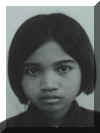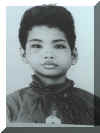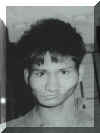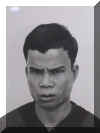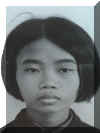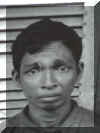



































PHOTOJOURNAL
December
21 - 24, 2000
Day 231, Thur, Dec. 21, 2000
–Very loud morning with traffic and talking on the non-private verandah
outside our window. It was a sunny day - the floods of yesterday  miraculously
miraculously
 dried up near our hotel.
After breakfast we walked to the palace, but apparently the flood waters
were still inside the gates so they wouldn’t let us in.
The moto driver who followed us from the hotel caught up to us so we
asked for a ride to the prison museum. Driving
a moto appears to be the occupation of choice (or necessity) for most teenage
boys. Our drivers wore button-down
shirts and baseball caps and spoke pretty good English.
The majority of Cambodians have no personal memory of the war, as they
are children - born after the Vietnamese invaded in 1979 and “liberated” the
country from the Khmer Rouge. The
moto ride went past the
dried up near our hotel.
After breakfast we walked to the palace, but apparently the flood waters
were still inside the gates so they wouldn’t let us in.
The moto driver who followed us from the hotel caught up to us so we
asked for a ride to the prison museum. Driving
a moto appears to be the occupation of choice (or necessity) for most teenage
boys. Our drivers wore button-down
shirts and baseball caps and spoke pretty good English.
The majority of Cambodians have no personal memory of the war, as they
are children - born after the Vietnamese invaded in 1979 and “liberated” the
country from the Khmer Rouge. The
moto ride went past the  Vietnamese friendship memorial, now derided by many
Cambodians because their neighbors overstayed their welcome and didn’t leave the
country for good until 1990. In
those 11 years, Cambodia was pretty much “Eastern bloc”, experiencing many
communist economic experiments along with their Vietnamese sponsors.
After this, Cambodia played host to the largest and most expensive UN
mission ever, including 15,000 peacekeepers,
Vietnamese friendship memorial, now derided by many
Cambodians because their neighbors overstayed their welcome and didn’t leave the
country for good until 1990. In
those 11 years, Cambodia was pretty much “Eastern bloc”, experiencing many
communist economic experiments along with their Vietnamese sponsors.
After this, Cambodia played host to the largest and most expensive UN
mission ever, including 15,000 peacekeepers,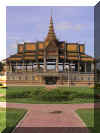 diplomats and administrators.
Then came the election of 1993, the lifting of the US-led economic
embargo in 1994, a coup in 1997, and another election in 1998.
Throughout this time, the Khmer Rouge continued its guerilla warfare
against Cambodians (and tourists). An
internal power struggle finally unseated Pol Pot after he executed one of his
rivals and 15 of their family members. He
was put on a sham trial by his former colleagues and supposedly died in custody
in 1998 (although many people still do not believe it).
The Khmer Rouge faded militarily (thanks to amnesties), and changed to a
political force headed by the current minister Hun Sen. With a history like
this, Cambodian politics continue to
diplomats and administrators.
Then came the election of 1993, the lifting of the US-led economic
embargo in 1994, a coup in 1997, and another election in 1998.
Throughout this time, the Khmer Rouge continued its guerilla warfare
against Cambodians (and tourists). An
internal power struggle finally unseated Pol Pot after he executed one of his
rivals and 15 of their family members. He
was put on a sham trial by his former colleagues and supposedly died in custody
in 1998 (although many people still do not believe it).
The Khmer Rouge faded militarily (thanks to amnesties), and changed to a
political force headed by the current minister Hun Sen. With a history like
this, Cambodian politics continue to  be impossible to follow.
Last year, there was even a half-baked coup attempt launched by the
Cambodian Freedom Fighters, an organization led by accountants in Long Beach,
California. Of course, the common
people are the ones suffering – trying to scrape out an existence in the
confusing, cloudy, middle ground where old military bureaucrats try out free
market reforms and another civil war could break out at any time.
be impossible to follow.
Last year, there was even a half-baked coup attempt launched by the
Cambodian Freedom Fighters, an organization led by accountants in Long Beach,
California. Of course, the common
people are the ones suffering – trying to scrape out an existence in the
confusing, cloudy, middle ground where old military bureaucrats try out free
market reforms and another civil war could break out at any time.
We continued past green parks,
fountains full of swimming children, monks in saffron robes and umbrellas, and
various monuments to political events. The
city has more character than we imagined – coming out of its shadowy history,
but still showing crumbling French colonial buildings.
In 1975, the French embassy was the site of the harrowing scenes
recounted in “The Killing Fields” when the Khmer Rouge ignored diplomatic
immunity and demanded the French to hand over all Cambodians taking refuge in
the embassy. The French are
now back, with businessmen and educators rather than soldiers and diplomats.
Further from the river, the flood nearly covered the tires of our motos
and stalled out a few others. The
road to the museum was washed out as well, so we continued to the central
market. The vast, yellow
spaceship-sized market is nicknamed “the city of gold” due to all the
jewelry sellers inside. Of course
we were more interested in the rambling, crowded rows of narrow stalls outside
the building. Everything from house wares
to clothes, books, electronics, and hardware.
It was like a combination Target,  Costco and Wal-Mart.
The vendors were mostly women – the young
Costco and Wal-Mart.
The vendors were mostly women – the young with floppy fishing hats and
the old favoring the traditional cloth wrapped around the head.
The food stalls were incredible – not just the standard fruits and
vegetables and fish, but the more savory aspects of Cambodian cuisine like
blackened baby chicks, grub worms and our personal favorite Asian delicacy –
flattened dried squid you can smell at 100 meters.
They also had cockroaches the size of mice.
The latter looked deep-fried without batter, but we weren’t quite ready
to give them a try.
with floppy fishing hats and
the old favoring the traditional cloth wrapped around the head.
The food stalls were incredible – not just the standard fruits and
vegetables and fish, but the more savory aspects of Cambodian cuisine like
blackened baby chicks, grub worms and our personal favorite Asian delicacy –
flattened dried squid you can smell at 100 meters.
They also had cockroaches the size of mice.
The latter looked deep-fried without batter, but we weren’t quite ready
to give them a try.
We went to a
bank to change dollars, but they don’t give local currency (Reals) – Naomi
got  directions from the guard while he casually pointed his AK-47 at her head. The other bank gave us 156,000 Reals for 40 US dollars.
As in Turkey and India, we could tell the state of a country’s economy
by the bucketful of bills required to pay for a cup of coffee.
We returned to our hotel for lunch, sitting next to a couple of
20-something Americans with teenage working girls, then walked to a Wat near the
hotel where we were accosted by a guy in a wheelchair.
directions from the guard while he casually pointed his AK-47 at her head. The other bank gave us 156,000 Reals for 40 US dollars.
As in Turkey and India, we could tell the state of a country’s economy
by the bucketful of bills required to pay for a cup of coffee.
We returned to our hotel for lunch, sitting next to a couple of
20-something Americans with teenage working girls, then walked to a Wat near the
hotel where we were accosted by a guy in a wheelchair.
 The palace was still closed, so we went to the National Museum
next
door, with its incredible collection of sculpture, bronze and pottery from the
Khmer Empires. An immaculately
decked out wedding party was taking photos inside the graceful red terracotta
building. Good thing
The palace was still closed, so we went to the National Museum
next
door, with its incredible collection of sculpture, bronze and pottery from the
Khmer Empires. An immaculately
decked out wedding party was taking photos inside the graceful red terracotta
building. Good thing  they were out
by sunset, because at that time the largest building-based bat population in the
world comes out of hiding places in the roof and starts to drop corrosive guano.
Outside the museum, like most attractions in town, a group of beggars and
amputees waits for tourists. We
give some to crippled older men, but not the kids.
they were out
by sunset, because at that time the largest building-based bat population in the
world comes out of hiding places in the roof and starts to drop corrosive guano.
Outside the museum, like most attractions in town, a group of beggars and
amputees waits for tourists. We
give some to crippled older men, but not the kids.
 We caught a moto ride with Tan, who
hangs out at the hotel. He has the
requisite
We caught a moto ride with Tan, who
hangs out at the hotel. He has the
requisite  baseball cap, a gold tooth, and a pet frog, which Jamie held during
the ride. He gave us a ride to Wat
Phnom, the namesake Wat of the city, where Naomi played with an elephant and
Jamie played hacky sack with some kids. Here
they play with a shuttlecock rather than a beanbag.
Inside the wats, the monks continue the worship and teaching that has
characterized their comeback after “Pol Pot time”
baseball cap, a gold tooth, and a pet frog, which Jamie held during
the ride. He gave us a ride to Wat
Phnom, the namesake Wat of the city, where Naomi played with an elephant and
Jamie played hacky sack with some kids. Here
they play with a shuttlecock rather than a beanbag.
Inside the wats, the monks continue the worship and teaching that has
characterized their comeback after “Pol Pot time”
All monks must cease wearing robes. Angkar will take no responsibility if this order is not carried out. The monks are not any wiser than you, the only wise man is the man who knows how to grow rice. Whether or not you say your prayers makes no difference to how the rice grows. You must drive this religion out of you, or else you are enemies of Angkar.
******
Day 232, Fri, Dec. 22, 2000
– One of the most depressing days of our journey as we get an up close look at the horrors of the Khmer Rouge regime.
We start by hiring a friend of the hotel for the 45-minute ride through
terrible roads and potholes still full of the downpour from two nights ago.
The peace and tranquility of the beautiful green rice fields studded with
palms and banana plants gives no hint at the things that happened here and the
“genocidal museum” down  a wet dirt road.
The Choeung Ek site is somber, with a few cripples and children begging
at the entrance and quiet tourists milling about.
We hired a guide, Chhouk, who had been working here for 30 years, nearly
from the very beginning when the Killing Fields were first discovered and
excavated. He even slept here
to guard it from any remnant Khmer Rouge guerillas who may not want the truth
revealed. As a memorial, they have
constructed a terrible, macabre stupa filled with the 8,968 human skulls
discovered here. The skulls are
separated by sex, age, and race – and he pointed out the holes, cracks and
slices in them from blows with bamboo sticks, knives, rifle butts and
a wet dirt road.
The Choeung Ek site is somber, with a few cripples and children begging
at the entrance and quiet tourists milling about.
We hired a guide, Chhouk, who had been working here for 30 years, nearly
from the very beginning when the Killing Fields were first discovered and
excavated. He even slept here
to guard it from any remnant Khmer Rouge guerillas who may not want the truth
revealed. As a memorial, they have
constructed a terrible, macabre stupa filled with the 8,968 human skulls
discovered here. The skulls are
separated by sex, age, and race – and he pointed out the holes, cracks and
slices in them from blows with bamboo sticks, knives, rifle butts and  clubs.
Bullets were only used in extreme cases since they were too expensive.
The children’s skulls were smashed to pieces from being whacked against
a tree.
clubs.
Bullets were only used in extreme cases since they were too expensive.
The children’s skulls were smashed to pieces from being whacked against
a tree.  They even had a
“European” skull section, with some jawbones showing where all the teeth had
been knocked out during their “interrogation”.
The effect is overwhelming – a mass of human suffering not unlike the
displays at Auschwitz, but the actual skulls haunt the imagination much more
than the clothes, eyeglasses and suitcases of the Nazi’s
They even had a
“European” skull section, with some jawbones showing where all the teeth had
been knocked out during their “interrogation”.
The effect is overwhelming – a mass of human suffering not unlike the
displays at Auschwitz, but the actual skulls haunt the imagination much more
than the clothes, eyeglasses and suitcases of the Nazi’s  victims. Some photos of the initial excavation work and some of the
key players in the horror were on display.
The statistics are amazing - 129 mass graves, of which 86 have been
excavated. We took a stroll through
green fields pockmarked with shallow water-filled divots from 3 to 10 meters
across. It was very hot, sunny, and
green with butterflies of all colors flitting around us – Chhouk said some
people
victims. Some photos of the initial excavation work and some of the
key players in the horror were on display.
The statistics are amazing - 129 mass graves, of which 86 have been
excavated. We took a stroll through
green fields pockmarked with shallow water-filled divots from 3 to 10 meters
across. It was very hot, sunny, and
green with butterflies of all colors flitting around us – Chhouk said some
people  believe the butterflies represent the spirits of those murdered here.
All along the footpath, scraps of clothing, shards of bone, and bullet
casings litter underfoot. Chhouk
knelt to scratch the surface and picked out a small tooth - he said he still
finds things every day. One would
think that after 21 years, everything would have been collected, picked apart
and put on display, but the ground keeps spitting up bits of evidence to ensure
the case will continue to be made against the murderers.
We saw the grave where 166 headless victims were found and the tree with
the bloodstains where the heads of babies were smashed. In the nook of another tree is a small shrine of teeth,
buttons and bones found by tourists – some people kneel and pray here.
believe the butterflies represent the spirits of those murdered here.
All along the footpath, scraps of clothing, shards of bone, and bullet
casings litter underfoot. Chhouk
knelt to scratch the surface and picked out a small tooth - he said he still
finds things every day. One would
think that after 21 years, everything would have been collected, picked apart
and put on display, but the ground keeps spitting up bits of evidence to ensure
the case will continue to be made against the murderers.
We saw the grave where 166 headless victims were found and the tree with
the bloodstains where the heads of babies were smashed. In the nook of another tree is a small shrine of teeth,
buttons and bones found by tourists – some people kneel and pray here.
Even
after all his time here, Chhouk is genuinely moved by his job; his desire to
educate people borne of his own experience.
He was 15 when his mother and father (a teacher) were killed and he went
off to the fields with the other Phnom Penh residents.
His older sister died some time later.
He said at first, mostly tourists came, but now he gets many Cambodians,
although he was reluctant to talk politics, especially since the current Prime
Minister, Hun Sen, was once aligned with Pol Pot. The time until his liberation was repeated in the same mantra
we heard from Vithouy – three years, eight months and twenty days.
killed and he went
off to the fields with the other Phnom Penh residents.
His older sister died some time later.
He said at first, mostly tourists came, but now he gets many Cambodians,
although he was reluctant to talk politics, especially since the current Prime
Minister, Hun Sen, was once aligned with Pol Pot. The time until his liberation was repeated in the same mantra
we heard from Vithouy – three years, eight months and twenty days.
“Everyone should learn about this
genocide and Pol Pot by seeing with their own eyes.  I think the Cambodian people and the international community
needs to punish Khmer for the war. I
think if Khmer Rouge still in government or ministers, maybe they fight again.
I hope international organizations support the Cambodian government for
development for future time. Education
and information is very important.”
I think the Cambodian people and the international community
needs to punish Khmer for the war. I
think if Khmer Rouge still in government or ministers, maybe they fight again.
I hope international organizations support the Cambodian government for
development for future time. Education
and information is very important.”
We paid Chhouk much more than he asked for the tour and picked up some small things at the souvenir shop.
The afternoon was spent at an even
more depressing and harrowing site, the former high school turned prison center
called S-21 (Special 21). Its
name, Toul Sleng also means hill of the poison tree in Khmer.
It was here that 30,000 victims – men, women and children of all walks
of life - came to be interrogated and tortured prior to being sent to the
killing fields. Walking past the
minefield victims standing calmly with their hands out, the barbed wire fence is
the only hint that the gray 3-story buildings surrounding a
the poison tree in Khmer.
It was here that 30,000 victims – men, women and children of all walks
of life - came to be interrogated and tortured prior to being sent to the
killing fields. Walking past the
minefield victims standing calmly with their hands out, the barbed wire fence is
the only hint that the gray 3-story buildings surrounding a 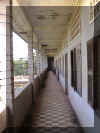 palm-studded
courtyard was used for such sinister purposes.
From a distance, the courtyard is peaceful, but as we approach, we see
the gravestones in the green grass and the barbed wire lining all three floors
of the school to dissuade suicide jumpers.
We are beginning to realize that anyone we meet over 25 was personally
affected (and many of those under 25 were orphaned or had one parent growing
up). Our guide,
palm-studded
courtyard was used for such sinister purposes.
From a distance, the courtyard is peaceful, but as we approach, we see
the gravestones in the green grass and the barbed wire lining all three floors
of the school to dissuade suicide jumpers.
We are beginning to realize that anyone we meet over 25 was personally
affected (and many of those under 25 were orphaned or had one parent growing
up). Our guide, Sath, lost family
and worked the fields from the age of 14. He
showed us the rooms where the last 14 victims were found by the Vietnamese
troops. The metal torture beds are
still where they found them along with blood stains and photographs of each
victim. It was these 14 who are
buried in the courtyard. At
liberation, there were just 7 prisoners left alive in the 1-meter by 3-meter brick
cells built in the classrooms of the school.
Sath showed us the old gymnastics bars, which were used for hanging
prisoners and dunking them in large vases full of toilet water until they
confessed. On the wall is a list of
the “rules” prisoners needed to follow at all times.
Sath, lost family
and worked the fields from the age of 14. He
showed us the rooms where the last 14 victims were found by the Vietnamese
troops. The metal torture beds are
still where they found them along with blood stains and photographs of each
victim. It was these 14 who are
buried in the courtyard. At
liberation, there were just 7 prisoners left alive in the 1-meter by 3-meter brick
cells built in the classrooms of the school.
Sath showed us the old gymnastics bars, which were used for hanging
prisoners and dunking them in large vases full of toilet water until they
confessed. On the wall is a list of
the “rules” prisoners needed to follow at all times.
The most unnerving and incredible
part of the museum are the rooms full of thousands of photographs taken of the
prisoners, both before and after their death.
Like the Nazis,  the Khmer
the Khmer  Rouge did a fantastic and morbid job of
documenting their own atrocities. The victims in the photos all had numbers on
their chest and most had their hands tied behind their backs.
Some faces were proud or defiant, but others were already beaten and
bruised. Terrified eyes stare right through us – all ages of women and men
(including some monks). The hardest to look at are the children - boys and girls
whose terrified eyes indicate their fear but did they have any idea what would
happen to them? One beautiful
little boy wore a heavy black chain around is neck for the last photo of his
laugh. One series shows a man and
his five children, proof of the Khmer Rouge policy to “not only cut the
Rouge did a fantastic and morbid job of
documenting their own atrocities. The victims in the photos all had numbers on
their chest and most had their hands tied behind their backs.
Some faces were proud or defiant, but others were already beaten and
bruised. Terrified eyes stare right through us – all ages of women and men
(including some monks). The hardest to look at are the children - boys and girls
whose terrified eyes indicate their fear but did they have any idea what would
happen to them? One beautiful
little boy wore a heavy black chain around is neck for the last photo of his
laugh. One series shows a man and
his five children, proof of the Khmer Rouge policy to “not only cut the  diseased grass, but pull up the roots as well”.
Towards the end, the prison would devour its own, as Khmer Rouge
guards and informers would turn on each other in mass paranoia.
What is perhaps most difficult to comprehend is how these atrocities
could be done TO Cambodians BY Cambodians.
The Nazis had a twisted logic that Jews were ethnically inferior, and the
Rwandans believed in “tribal” inferiority; but this was purely a hatred and
mass hysteria based on economic and social class – more akin to the French
Revolution and the politics of the guillotine.
diseased grass, but pull up the roots as well”.
Towards the end, the prison would devour its own, as Khmer Rouge
guards and informers would turn on each other in mass paranoia.
What is perhaps most difficult to comprehend is how these atrocities
could be done TO Cambodians BY Cambodians.
The Nazis had a twisted logic that Jews were ethnically inferior, and the
Rwandans believed in “tribal” inferiority; but this was purely a hatred and
mass hysteria based on economic and social class – more akin to the French
Revolution and the politics of the guillotine.
We had to get some air before continuing to the rooms displaying
paintings made by one of the  7
7
 liberated prisoners.
Apparently, the last seven were only kept alive because they served some
useful purpose to the Khmer Rouge – for example as sculptors and painters. The paintings on display show the “interrogations” in
process in lurid color. There were
also photos and a metal bust of “Blood Brother Number One” himself – Pol
Pot. Sath does not believe he is
really dead. He said “some people
escape US bombs, but nobody escape Pol Pot”.
liberated prisoners.
Apparently, the last seven were only kept alive because they served some
useful purpose to the Khmer Rouge – for example as sculptors and painters. The paintings on display show the “interrogations” in
process in lurid color. There were
also photos and a metal bust of “Blood Brother Number One” himself – Pol
Pot. Sath does not believe he is
really dead. He said “some people
escape US bombs, but nobody escape Pol Pot”.
“In Cambodia everything is
important because we start with nothing in 1979.
We need health, education, and money.
The salary of the government is low.
Like me, I have $11 per month”
We returned to the hotel and watched the sunset from our
balcony, watching the  boats
on the river, cripples, kids, and musicians along the flag-lined boulevard
– there was a very calm, provincial feel – a little melancholy, but nothing
like what we saw today. The most
amazing thing we've experienced in Cambodia is the vast contrast between the
gentleness and calm personalities of the people we've met and the history of violence
this country has seen - from the time of the Khmer empire conquests to "Pol
Pot time". Like most visitors, we cannot reconcile the disparity.
boats
on the river, cripples, kids, and musicians along the flag-lined boulevard
– there was a very calm, provincial feel – a little melancholy, but nothing
like what we saw today. The most
amazing thing we've experienced in Cambodia is the vast contrast between the
gentleness and calm personalities of the people we've met and the history of violence
this country has seen - from the time of the Khmer empire conquests to "Pol
Pot time". Like most visitors, we cannot reconcile the disparity.
For dinner, we walked to the Foreign Correspondent’s
Club, the center of expat and journalist life in the city. We picked up a special year-end issue of the Phnom Penh Post
that included a  depressing summary of the biggest stories of the year –
including illegal exports of timber, a British headmaster convicted of
debauchery, a “party pagoda” in Pailin where monks did more than study and
meditate, seven East European prostitutes held captive at the Best Western
Hotel, and a “babies for sale” orphanage where Westerners paid US$11,500 but
the
depressing summary of the biggest stories of the year –
including illegal exports of timber, a British headmaster convicted of
debauchery, a “party pagoda” in Pailin where monks did more than study and
meditate, seven East European prostitutes held captive at the Best Western
Hotel, and a “babies for sale” orphanage where Westerners paid US$11,500 but
the  parents received US$100. We
hope it’s just journalistic bias on the part of the newspaper, but there were
no stories about factory openings, business expansion, school performance, or
non-profit successes. The restaurant had a vast interior, pool table, famous
historical photos on the walls and a verandah facing the river.
Of course all customers were Western.
One of the photos showed the jubilation of residents climbing all over a
Khmer Rouge truck as it entered Phnom Penh.
They were celebrating the end to the civil war, but they had no idea what
would follow.
parents received US$100. We
hope it’s just journalistic bias on the part of the newspaper, but there were
no stories about factory openings, business expansion, school performance, or
non-profit successes. The restaurant had a vast interior, pool table, famous
historical photos on the walls and a verandah facing the river.
Of course all customers were Western.
One of the photos showed the jubilation of residents climbing all over a
Khmer Rouge truck as it entered Phnom Penh.
They were celebrating the end to the civil war, but they had no idea what
would follow.
*******
Day 233, Sat, Dec. 23, 2000 – More bad news today when we got a chance to watch CNN. A suicide bomber in Gaza (although we’re not sure if he earned his “martyr” points since he didn’t kill anyone), Milosevic is back in Serbia, Estrada is on the way out of Manila due to using a fake name and a US$3 million check for a house for his mistress, Fujimori is now in Japan fighting extradition back to Peru, and some tourists have been killed at the Red Fort in Delhi.
 Today we finally got into the
grounds of the royal palace. It is
very green and shiny and appears to have been built yesterday although some
areas are
over 100 years old. Since
Sihanouk’s return from exile in China in 1991, the
Today we finally got into the
grounds of the royal palace. It is
very green and shiny and appears to have been built yesterday although some
areas are
over 100 years old. Since
Sihanouk’s return from exile in China in 1991, the  palace living quarters are
now closed to the public. It is
here that he suffered the betrayal of the Khmer Rouge, when they turned on their
initial supporter and killed 19 members of his family (including his favorite
son and daughter) and held him under house arrest, after destroying much of the
palace treasures. This must have
been hell for the once enigmatic god-king and one of the most colorful leaders
of the century (he once wrote, directed and starred in 9 movies). Sihanouk was reinstated as King in 1993 and has retained some
reverence
palace living quarters are
now closed to the public. It is
here that he suffered the betrayal of the Khmer Rouge, when they turned on their
initial supporter and killed 19 members of his family (including his favorite
son and daughter) and held him under house arrest, after destroying much of the
palace treasures. This must have
been hell for the once enigmatic god-king and one of the most colorful leaders
of the century (he once wrote, directed and starred in 9 movies). Sihanouk was reinstated as King in 1993 and has retained some
reverence from the citizenry
- mostly due to his ancestors and his role in
Independence from France. Even his early support of the Khmer Rouge
is seen as a forgivable mistake in judgment by some. His son is in politics, but there is rampant
speculation what will
from the citizenry
- mostly due to his ancestors and his role in
Independence from France. Even his early support of the Khmer Rouge
is seen as a forgivable mistake in judgment by some. His son is in politics, but there is rampant
speculation what will  happen when he is gone.
We were allowed to view the throne hall where receptions were held
(complete with a gold statue of Sihanouk), several of the wats, and a long painted
mural of Ramayana battles. The
highlight of the palace, however, is the beautiful Silver Pagoda - named for the
5,281 squares of silver (each weighing one kilo) that make up the floor of the temple.
The unusual floor provides a nice coolness when
happen when he is gone.
We were allowed to view the throne hall where receptions were held
(complete with a gold statue of Sihanouk), several of the wats, and a long painted
mural of Ramayana battles. The
highlight of the palace, however, is the beautiful Silver Pagoda - named for the
5,281 squares of silver (each weighing one kilo) that make up the floor of the temple.
The unusual floor provides a nice coolness when you step inside after
removing your shoes. Although they destroyed 60% of the interior, the Khmer Rouge
claimed to preserve the pagoda as a symbol of the richness of the Khmer cultural
heritage. Inside is an incredible
collection of statues, jewelry, carvings, masks, furniture, puppets and gifts
amassed by the royal family over the years.
The wat is also known as the Temple of the Emerald Buddha due to the
baccarat crystal Buddha high on a golden pedestal. In front of this stands a life-sized gold Buddha encrusted
with 9,584 diamonds and 9 kilos of gold. The
collection is among the richest we have seen – amazing considering the past
and current state of the country.
you step inside after
removing your shoes. Although they destroyed 60% of the interior, the Khmer Rouge
claimed to preserve the pagoda as a symbol of the richness of the Khmer cultural
heritage. Inside is an incredible
collection of statues, jewelry, carvings, masks, furniture, puppets and gifts
amassed by the royal family over the years.
The wat is also known as the Temple of the Emerald Buddha due to the
baccarat crystal Buddha high on a golden pedestal. In front of this stands a life-sized gold Buddha encrusted
with 9,584 diamonds and 9 kilos of gold. The
collection is among the richest we have seen – amazing considering the past
and current state of the country.
 Outside, a group of children were
putting on a dance performance, similar to the one we saw in Siem Reap, but a
little more amateur and a lot more cute. From
the palace we walked past a crowded soccer field to London Books, where we
talked to the owner – an American guy who’s been here for years, after
marrying
Outside, a group of children were
putting on a dance performance, similar to the one we saw in Siem Reap, but a
little more amateur and a lot more cute. From
the palace we walked past a crowded soccer field to London Books, where we
talked to the owner – an American guy who’s been here for years, after
marrying  a Khmer woman. He said
there is very little hope for the future given the uncertainty in the
government. The recent attempts at
a Khmer woman. He said
there is very little hope for the future given the uncertainty in the
government. The recent attempts at forming some sort of war crimes tribunal have been thwarted by those who may be
found culpable and the people have very little power, other than international
pressure and education. Steps are
under way, but it will be a very delicate and potentially divisive program –
even with the support of the UN and US Senator (and Vietnam War veteran and
one-time presidential candidate) John Kerry.
forming some sort of war crimes tribunal have been thwarted by those who may be
found culpable and the people have very little power, other than international
pressure and education. Steps are
under way, but it will be a very delicate and potentially divisive program –
even with the support of the UN and US Senator (and Vietnam War veteran and
one-time presidential candidate) John Kerry.
From the bookstore, we walked to one of those Nuevo-chic
French coffee houses with Angkor Wat etchings on the wall, and then took a moto
back to the hotel. After dinner we
decided to go to the infamous Heart of Darkness bar.
It was stuffed with expats, most in their 20s, with no memory (or care)
whatsoever about the past – just playing pool, watching videos and drinking
with the local bar girls. We
negotiated motos to another place, Sharky’s, although it was not far away.
They say street crime is way down, but we weren’t taking any chances.
We were glad we didn’t when we passed the gangs of teenagers, sleeping
homeless folks and fairly dodge karaoke/massage bars along the way. Signs at Sharky’s said “No Weapons, No Drugs” and “Beware of Pick Pockets and Loose Women”.
There was plenty of the former, as I was approached by three of four in
the 5 minutes Naomi was in the ladies’ room.
Around the bar was the standard group of pudgy western guys pawing young
prostitutes. The girls seemed to be
having a good time chatting and joking amongst
“Beware of Pick Pockets and Loose Women”.
There was plenty of the former, as I was approached by three of four in
the 5 minutes Naomi was in the ladies’ room.
Around the bar was the standard group of pudgy western guys pawing young
prostitutes. The girls seemed to be
having a good time chatting and joking amongst  themselves until their employers
needed some reassuring attention. In
some respects, this was more depressing than Patpong Road in Bangkok because all
of the girls here were definitely trying to get sleeping jobs rather than just
dancing around a pole in a bikini. We
left after having a little run-in with a white guy who gave me a sly nod of
recognition when he saw me with Naomi. By
the time we got back to the hotel, we hade to wake the kids who were sleeping in
the lobby with their mopeds to open the iron gates.
themselves until their employers
needed some reassuring attention. In
some respects, this was more depressing than Patpong Road in Bangkok because all
of the girls here were definitely trying to get sleeping jobs rather than just
dancing around a pole in a bikini. We
left after having a little run-in with a white guy who gave me a sly nod of
recognition when he saw me with Naomi. By
the time we got back to the hotel, we hade to wake the kids who were sleeping in
the lobby with their mopeds to open the iron gates.
*******
Day 234, Sun, Dec. 24, 2000
– This morning, we took a ride out to the “Russian Market”,  a covered
bazaar of sorts, specializing in pirated shirts, movies and music CDs.
We bought a few things, but still could not find and DVDs about the war.
We had a great Indian lunch, but we were the only ones in the restaurant
all day. Back at the Hotel California, we met up again with Tan, the moto
driver.
a covered
bazaar of sorts, specializing in pirated shirts, movies and music CDs.
We bought a few things, but still could not find and DVDs about the war.
We had a great Indian lunch, but we were the only ones in the restaurant
all day. Back at the Hotel California, we met up again with Tan, the moto
driver.
“What is most important is money
for my family, especially my baby. So
I work every day from 7 in the morning until 11 at night.
I think for my baby, it will be better in the future because they stop
fighting. So he go to school and
get education. I want maybe one
more baby because more than 2 is too much to feed.
We want more tourists to come here because it is safe – no more
political – there are many things to see.”
from 7 in the morning until 11 at night.
I think for my baby, it will be better in the future because they stop
fighting. So he go to school and
get education. I want maybe one
more baby because more than 2 is too much to feed.
We want more tourists to come here because it is safe – no more
political – there are many things to see.”
 This was our last day – a
much-too-short visit in such a complex land.
We
This was our last day – a
much-too-short visit in such a complex land.
We  sat on the balcony trying to make sense of the senseless while
watching the crowd on the promenade below - monks, musicians, balloon-sellers,
crippled men in army fatigues, and a little kid wearing only a gold necklace.
The moto traffic was heavy, including kids with Santa Clause hats and many
families of five squishing together. One
pair of sisters had Christmas hats, sunglasses and scarves for the fumes.
sat on the balcony trying to make sense of the senseless while
watching the crowd on the promenade below - monks, musicians, balloon-sellers,
crippled men in army fatigues, and a little kid wearing only a gold necklace.
The moto traffic was heavy, including kids with Santa Clause hats and many
families of five squishing together. One
pair of sisters had Christmas hats, sunglasses and scarves for the fumes.

 We posed for pictures with the friendly staff at the hotel before getting
in a taxi to the airport. At the
airport, we met Loy, a young guy working security, who wanted to practice his
English. He is working two jobs to make enough money to continue his
education. Loy’s other job is in
the government anti-corruption division. He
never shows up there, but he gets paid anyway.
We posed for pictures with the friendly staff at the hotel before getting
in a taxi to the airport. At the
airport, we met Loy, a young guy working security, who wanted to practice his
English. He is working two jobs to make enough money to continue his
education. Loy’s other job is in
the government anti-corruption division. He
never shows up there, but he gets paid anyway.
*********
If you would like to follow our adventure to Vietnam, please click here: Photojournal December 25 - January 1, 2001
If you have any comments, suggestions, or other feedback, please see our contact information and send us a note.
Thanks for your support!










